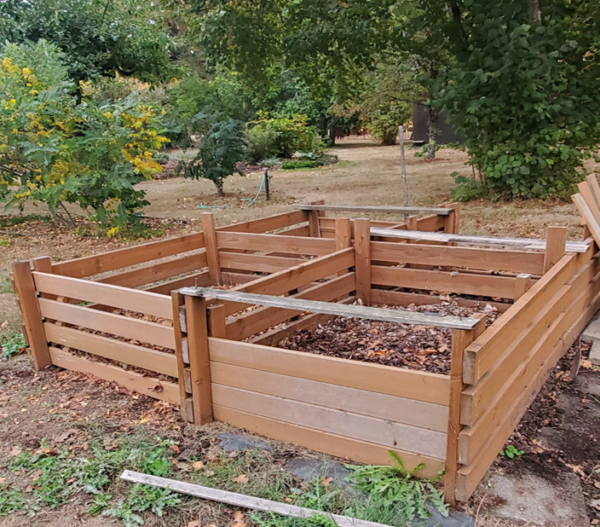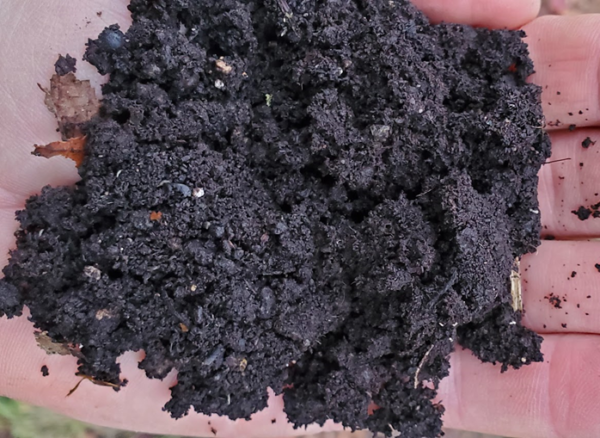The Dirt | Leave the Leaves
This fall I’ve had several people ask me whether they should stop raking leaves in their yards. They wonder if it makes sense to haul away this free organic matter, and then go buy new bark mulch. I’m really excited to hear that people are thinking this way!

One of the goals in a regenerative landscape is to follow nature’s patterns. In a forest, leaves, needles, branches, and all kinds of organic debris fall on top of the soil every day. This stuff breaks down and turns into food for the fungi and microbes that help feed the soil and plants. This healthy, living soil also stores carbon that would otherwise become carbon dioxide in the atmosphere!
Are there any drawbacks to leaving the leaves?
The answer is “Yes, but…” Here are some things to think about:
- If you have a small lot with lots of trees, you’ll probably have so many leaves that they’ll get too thick and smother small plants or lawns.
- Piles of leaves may not fully decompose in one year, which means you could end up with too many leaves over time. Oak leaves especially seem to take a long time to break down.
- If leaves are piled up against structures such as fences, they can cause staining and premature rot.
- Leaves left in the landscape may not look good to everyone.
- Loose piles of leaves could blow around the neighborhood.

How to use leaves in your yard
- Leave the leaves! If you don’t have too many trees and the leaves don’t pile up from year to year, you can just let them sit where they fall.
- Partial leaf removal: A good compromise is to remove all or some of the leaves from lawns and formal areas of your yard. You can put these leaves in less-formal spaces in your yard, or rake them under large shrubs. If you use this strategy, you’ll have to pay attention from year to year to see how quickly they decompose so you know how many leaves you can leave.
- Natural fertilizer: Large amounts of leaves can smother grass fairly quickly. However, if you can mow leaves to chop them up and leave them on the lawn, they can be beneficial. It takes a certain amount of experimenting to figure out how much you can leave without it being too much.
- Make leaf mold: Allowing leaves to rot in a contained space will shrink them down to where you can use them later as mulch.
How to make leaf mold
Since leaves may take a couple years to decompose, you’ll need designated spaces where you can store leaves from year to year. The simplest method is to make a new pile every year and forget about it. However, piles tend to get scattered and messy, so you might consider making a container. This can be made out of just about anything, such as a circle of fence wire or a bin made from wood or old pallets. The size of the container depends on how many leaves you want to turn into leaf mold. Bigger is better. All you have to do is add leaves into the container or bin. After 1, 2, or maybe even 3 years, these leaves will break down into a dark, rich, soil-like material.
How to make leaf mold break down faster
You can help the leaves decompose much faster, but it is more work. Here’s a few things you can try:
- Shred the leaves before you add them to the pile. If you collect leaves with your lawnmower, they’ll already be shredded. Otherwise you’ll need a chipper or shredder.
- Make sure the piles stay moist. Microbes need moisture to break down leaves. If the leaves in the middle of the pile feel dry to the touch, they won’t decompose very quickly.
- Turn the piles. This adds oxygen into the pile, which is also needed by microbes. Keep in mind when you turn a pile you might destroy some of the structures that fungi make throughout the pile, so be gentle, and don’t turn too often.
- Add green material, like grass clippings. Leaves tend to be low in Nitrogen. Decomposition happens more slowly when less Nitrogen is present. Beware of adding too many grass clippings — they can get smelly. You can also add kitchen scraps, but be aware that you might attract critters such as rats.

Using leaf mold in your landscape
Leaf mold can be spread around your landscape just like mulch or compost. It won’t be as smooth and formal-looking as bark mulch, but it is better for the soil, as it contains more nutrients than bark. It can be used any time, even if it’s not fully decomposed. If you really like the traditional look of bark mulch, you can spread a thin layer of leaf mold on the soil and cover it with your favorite bark.
Benefits of leaf mulch or leaf mold
- It’s more sustainable! Less fossil fuel is needed by collection services. Why haul away all your mulch and then go buy it from somewhere else?
- Less work for you! Leaving leaves on the ground is the ultimate no-work landscaping. You may still need to rake leaves from your lawn and some other planting beds, but if you set up a convenient leaf mold container, it may still be less work than taking the leaves out to be collected by the city.
- Saves cost! Free leaf mold costs a lot less than conventional mulch.
- Feed the soil and your plants! Tree roots gather nutrients from deep in the soil. This is a vital part of the nutrient cycle where healthy soil is built and nutrients become available to other plants. If you think about it, nobody fertilizes a forest – it does that for itself!
- Retain moisture! Carbon-rich organic matter like leaf mold can hold many times its weight in water. A layer of mulch also reduces evaporation from the soil.
- Moderate soil temperature! Leaf mold (or other mulch) keeps the soil from getting too hot or too cold, which can really help all the soil critters and microbes who are working hard for you.
- Complete the cycle! Keeping the leaves where they came from is a great way to work with nature, not against it.
Try this at home!
Making any change in your yard can be a little scary. But using free resources that nature provides makes sense. If you’re not sure if it will work for you, try it for a year in part of your yard until you figure out the best method for you. You won’t regret it, and your local wildlife will thank you!
